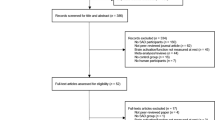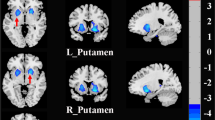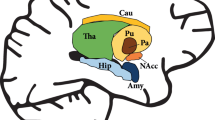Abstract
Social anxiety disorder (SAD) is characterized by fears of social and performance situations. Cognitive behavioral group therapy (CBGT) has in general positive effects on symptoms, distress and avoidance in SAD. Prior studies found increased cortical volumes and decreased fractional anisotropy (FA) in SAD compared with healthy controls (HCs). Thirty-three participants diagnosed with SAD attended in a 10-week CBGT and were scanned before and after therapy. We applied three neuroimaging methods–surface-based morphometry, diffusion tensor imaging and network-based statistics–each with specific longitudinal processing protocols, to investigate CBGT-induced structural brain alterations of the gray and white matter (WM). Surface-based morphometry revealed a significant cortical volume reduction (pre- to post-treatment) in the left inferior parietal cortex, as well as a positive partial correlation between treatment success (indexed by reductions in Liebowitz Social Anxiety Scale) and reductions in cortical volume in bilateral dorsomedial prefrontal cortex. Diffusion tensor imaging analysis revealed a significant increase in FA in bilateral uncinate fasciculus and right inferior longitudinal fasciculus. Network-based statistics revealed a significant increase of structural connectivity in a frontolimbic network. No partial correlations with treatment success have been found in WM analyses. For, we believe, the first time, we present a distinctive pattern of longitudinal structural brain changes after CBGT measured with three established magnetic resonance imaging analyzing techniques. Our findings are in line with previous cross-sectional, unimodal SAD studies and extent them by highlighting anatomical brain alterations that point toward the level of HCs in parallel with a reduction in SAD symptomatology.
This is a preview of subscription content, access via your institution
Access options
Subscribe to this journal
Receive 12 print issues and online access
$259.00 per year
only $21.58 per issue
Buy this article
- Purchase on Springer Link
- Instant access to full article PDF
Prices may be subject to local taxes which are calculated during checkout





Similar content being viewed by others
References
Kessler RC, Berglund P, Demler O, Jin R, Merikangas KR, Walters EE . Lifetime prevalence and age-of-onset distributions of DSM-IV disorders in the National Comorbidity Survey Replication. Arch Gen Psychiatry 2005; 62: 593–602.
Kessler RC, Ruscio AM, Shear K, Wittchen HU . Epidemiology of anxiety disorders. Curr Top Behav Neurosci 2010; 2: 21–35.
Furmark T . Social phobia: overview of community surveys. Acta Psychiatr Scand 2002; 105: 84–93.
Barrera TL, Norton PJ . Quality of life impairment in generalized anxiety disorder, social phobia, and panic disorder. J Anxiety Disord 2009; 23: 1086–1090.
Fehm L, Beesdo K, Jacobi F, Fiedler A . Social anxiety disorder above and below the diagnostic threshold: prevalence, comorbidity and impairment in the general population. Soc Psychiatry Psychiatr Epidemiol 2008; 43: 257–265.
APA Diagnostic and Statistical Manual of Mental Disorders, 5th edn. American Psychiatric Association (APA): Washington, DC, USA, 2013.
Rosellini AJ, Rutter LA, Bourgeois ML, Emmert-Aronson BO, Brown TA . The relevance of age of onset to the psychopathology of social phobia. J Psychopathol Behav Assess 2013; 35: 356–365.
Ramsawh HJ, Raffa SD, Edelen MO, Rende R, Keller MB . Anxiety in middle adulthood: effects of age and time on the 14-year course of panic disorder, social phobia and generalized anxiety disorder. Psychol Med 2009; 39: 615–624.
Ramsawh HJ, Weisberg RB, Dyck I, Stout R, Keller MB . Age of onset, clinical characteristics, and 15-year course of anxiety disorders in a prospective, longitudinal, observational study. J Affect Disord 2011; 132: 260–264.
Mayo-Wilson E, Dias S, Mavranezouli I, Kew K, Clark DM, Ades AE et al. Psychological and pharmacological interventions for social anxiety disorder in adults: a systematic review and network meta-analysis. Lancet Psychiat 2014; 1: 368–376.
Barsaglini A, Sartori G, Benetti S, Pettersson-Yeo W, Mechelli A . The effects of psychotherapy on brain function: a systematic and critical review. Prog Neurobiol 2014; 114: 1–14.
Brühl AB, Delsignore A, Komossa K, Weidt S . Neuroimaging in social anxiety disorder-a meta-analytic review resulting in a new neurofunctional model. Neurosci Biobehav R 2014; 47: 260–280.
Talati A, Pantazatos SP, Schneier FR, Weissman MM, Hirsch J . Gray matter abnormalities in social anxiety disorder: primary, replication, and specificity studies. Biol Psychiatry 2013; 73: 75–84.
Liao W, Xu Q, Mantini D, Ding J, Machado-de-Sousa JP, Hallak JE et al. Altered gray matter morphometry and resting-state functional and structural connectivity in social anxiety disorder. Brain Res 2011; 1388: 167–177.
Baur V, Hänggi J, Rufer M, Delsignore A, Jäncke L, Herwig U et al. White matter alterations in social anxiety disorder. J Psychiatr Res 2011; 45: 1366–1372.
Baur V, Brühl AB, Herwig U, Eberle T, Rufer M, Delsignore A et al. Evidence of frontotemporal structural hypoconnectivity in social anxiety disorder: a quantitative fiber tractography study. Hum Brain Mapp 2013; 34: 437–446.
Phan KL, Orlichenko A, Boyd E, Angstadt M, Coccaro EF, Liberzon I et al. Preliminary evidence of white matter abnormality in the uncinate fasciculus in generalized social anxiety disorder. Biol Psychiatry 2009; 66: 691–694.
Whitfield-Gabrieli S, Ghosh SS, Nieto-Castanon A, Saygin Z, Doehrmann O, Chai XJ et al. Brain connectomics predict response to treatment in social anxiety disorder. Mol Psychiatry 2016; 21: 680–685.
Ding J, Chen H, Qiu C, Liao W, Warwick JM, Duan X et al. Disrupted functional connectivity in social anxiety disorder: a resting-state fMRI study. Magn Reson Imaging 2011; 29: 701–711.
Hahn A, Stein P, Windischberger C, Weissenbacher A, Spindelegger C, Moser E et al. Reduced resting-state functional connectivity between amygdala and orbitofrontal cortex in social anxiety disorder. NeuroImage 2011; 56: 881–889.
Annett M . A classification of hand preference by association analysis. Br J Psychol 1970; 61: 303–321.
Sheehan DV, Lecrubier Y, Sheehan KH, Amorim P, Janavs J, Weiller E et al. The Mini-International Neuropsychiatric Interview (M.I.N.I.): the development and validation of a structured diagnostic psychiatric interview for DSM-IV and ICD-10. J Clin Psychiatry 1998; 59: 22–33; quiz 34–57.
Delsignore A, Carraro G, Mathier F, Znoj H, Schnyder U . Perceived responsibility for change as an outcome predictor in cognitive-behavioural group therapy. Br J Clin Psychol 2008; 47 (Pt 3): 281–293.
Heimberg RG, Horner KJ, Juster HR, Safren SA, Brown EJ, Schneier FR et al. Psychometric properties of the Liebowitz Social Anxiety Scale. Psychol Med 1999; 29: 199–212.
Heimberg RG, Mueller GP, Holt CS, Hope DA, Liebowitz MR . Assessment of anxiety in social interaction and being observed by others: the social interaction anxiety scale and the Social Phobia Scale. Behav Ther 1992; 23: 53–73.
Beck AT, Ward CH, Mendelson M, Mock J, Erbaugh J . An inventory for measuring depression. Arch Gen Psychiatry 1961; 4: 561–571.
Reuter M, Schmansky NJ, Rosas HD, Fischl B . Within-subject template estimation for unbiased longitudinal image analysis. NeuroImage 2012; 61: 1402–1418.
Reuter M, Fischl B . Avoiding asymmetry-induced bias in longitudinal image processing. NeuroImage 2011; 57: 19–21.
Reuter M, Rosas HD, Fischl B . Highly accurate inverse consistent registration: a robust approach. NeuroImage 2010; 53: 1181–1196.
de Groot M, Vernooij MW, Klein S, Ikram MA, Vos FM, Smith SM et al. Improving alignment in tract-based spatial statistics: evaluation and optimization of image registration. NeuroImage 2013; 76: 400–411.
Smith SM, Jenkinson M, Johansen-Berg H, Rueckert D, Nichols TE, Mackay CE et al. Tract-based spatial statistics: voxelwise analysis of multi-subject diffusion data. NeuroImage 2006; 31: 1487–1505.
Behrens TE, Woolrich MW, Jenkinson M, Johansen-Berg H, Nunes RG, Clare S et al. Characterization and propagation of uncertainty in diffusion-weighted MR imaging. Magn Reson Med 2003; 50: 1077–1088.
Madhyastha T, Merillat S, Hirsiger S, Bezzola L, Liem F, Grabowski T et al. Longitudinal reliability of tract-based spatial statistics in diffusion tensor imaging. Hum Brain Mapp 2014; 35: 4544–4555.
Yekutieli D, Benjamini Y . Resampling-based false discovery rate controlling multiple test procedures for correlated test statistics. J Stat Plan Infer 1999; 82: 171–196.
Benjamini Y, Hochberg Y . Controlling the false discovery rate - a practical and powerful approach to multiple testing. J Roy Stat Soc B Met 1995; 57: 289–300.
Tzourio-Mazoyer N, Landeau B, Papathanassiou D, Crivello F, Etard O, Delcroix N et al. Automated anatomical labeling of activations in SPM using a macroscopic anatomical parcellation of the MNI MRI single-subject brain. NeuroImage 2002; 15: 273–289.
Zalesky A, Fornito A, Bullmore ET . Network-based statistic: identifying differences in brain networks. NeuroImage 2010; 53: 1197–1207.
Brühl AB, Hänggi J, Baur V, Rufer M, Delsignore A, Weidt S et al. Increased cortical thickness in a frontoparietal network in social anxiety disorder. Hum Brain Mapp 2014; 35: 2966–2977.
Beesdo-Baum K, Knappe S, Fehm L, Hofler M, Lieb R, Hofmann SG et al. The natural course of social anxiety disorder among adolescents and young adults. Acta Psychiatr Scand 2012; 126: 411–425.
Etkin A . Functional neuroanatomy of anxiety: a neural circuit perspective. Curr Top Behav Neurosci 2010; 2: 251–277.
Goldin PR, Lee I, Ziv M, Jazaieri H, Heimberg RG, Gross JJ . Trajectories of change in emotion regulation and social anxiety during cognitive-behavioral therapy for social anxiety disorder. Behav Res Ther 2014; 56: 7–15.
O'Toole MS, Mennin DS, Hougaard E, Zachariae R, Rosenberg NK . Cognitive and emotion regulation change processes in cognitive behavioural therapy for social anxiety disorder. Clin Psychol Psychother 2015; 22: 667–676.
Aldao A, Jazaieri H, Goldin PR, Gross JJ . Adaptive and maladaptive emotion regulation strategies: interactive effects during CBT for social anxiety disorder. J Anxiety Disord 2014; 28: 382–389.
Odlaug BL, Chamberlain SR, Derbyshire KL, Leppink EW, Grant JE . Impaired response inhibition and excess cortical thickness as candidate endophenotypes for trichotillomania. J Psychiatr Res 2014; 59: 167–173.
Kharitonova M, Martin RE, Gabrieli JD, Sheridan MA . Cortical gray-matter thinning is associated with age-related improvements on executive function tasks. Dev Cogn Neurosci 2013; 6: 61–71.
Cieslik EC, Mueller VI, Eickhoff CR, Langner R, Eickhoff SB . Three key regions for supervisory attentional control: evidence from neuroimaging meta-analyses. Neurosci Biobehav R 2015; 48: 22–34.
Szczepanski SM, Pinsk MA, Douglas MM, Kastner S, Saalmann YB . Functional and structural architecture of the human dorsal frontoparietal attention network. Proc Natl Acad Sci USA 2013; 110: 15806–15811.
Sylvester CM, Corbetta M, Raichle ME, Rodebaugh TL, Schlaggar BL, Sheline YI et al. Functional network dysfunction in anxiety and anxiety disorders. Trends Neurosci 2012; 35: 527–535.
Reif A, Richter J, Straube B, Hofler M, Lueken U, Gloster AT et al. MAOA and mechanisms of panic disorder revisited: from bench to molecular psychotherapy. Mol Psychiatry 2014; 19: 122–128.
Baur V, Hänggi J, Jäncke L . Volumetric associations between uncinate fasciculus, amygdala, and trait anxiety. BMC Neurosci 2012; 13: 4.
Modi S, Trivedi R, Singh K, Kumar P, Rathore RK, Tripathi RP et al. Individual differences in trait anxiety are associated with white matter tract integrity in fornix and uncinate fasciculus: preliminary evidence from a DTI based tractography study. Behav Brain Res 2013; 238: 188–192.
Doehrmann O, Ghosh SS, Polli FE, Reynolds GO, Horn F, Keshavan A et al. Predicting treatment response in social anxiety disorder from functional magnetic resonance imaging. JAMA Psychiatry 2013; 70: 87–97.
Quide Y, Witteveen AB, El-Hage W, Veltman DJ, Olff M . Differences between effects of psychological versus pharmacological treatments on functional and morphological brain alterations in anxiety disorders and major depressive disorder: a systematic review. Neurosci Biobehav R 2012; 36: 626–644.
Hilbert K, Evens R, Maslowski NI, Wittchen HU, Lueken U . Neurostructural correlates of two subtypes of specific phobia: a voxel-based morphometry study. Psychiatry Res 2015; 231: 168–175.
Lai CH, Wu YT . The gray matter alterations in major depressive disorder and panic disorder: putative differences in the pathogenesis. J Affect Disord 2015; 186: 1–6.
Na KS, Ham BJ, Lee MS, Kim L, Kim YK, Lee HJ et al. Decreased gray matter volume of the medial orbitofrontal cortex in panic disorder with agoraphobia: a preliminary study. Prog Neuropsychopharmacol Biol Psychiatry 2013; 45: 195–200.
Cassimjee N, Fouche JP, Burnett M, Lochner C, Warwick J, Dupont P et al. Changes in regional brain volumes in social anxiety disorder following 12 weeks of treatment with escitalopram. Metab Brain Dis 2010; 25: 369–374.
Acknowledgements
This study was funded by two Swiss National Science Foundation (SNSF) grants 320030_133009 and 320030_146972. We thank Hansruedi Baetschmann for the usage of his MATLAB scripts that support the network-based statistic (NBS) tool. We would like to thank all participants of our SAD group for their attendance in our study. Furthermore, we would like to thank to all clinicians and all the members of our research groups for collecting and quality controlling the neuroimaging data.
Author information
Authors and Affiliations
Corresponding author
Ethics declarations
Competing interests
The authors declare no conflict of interest.
Additional information
Supplementary Information accompanies the paper on the Molecular Psychiatry website
Rights and permissions
About this article
Cite this article
Steiger, V., Brühl, A., Weidt, S. et al. Pattern of structural brain changes in social anxiety disorder after cognitive behavioral group therapy: a longitudinal multimodal MRI study. Mol Psychiatry 22, 1164–1171 (2017). https://doi.org/10.1038/mp.2016.217
Received:
Revised:
Accepted:
Published:
Issue Date:
DOI: https://doi.org/10.1038/mp.2016.217
This article is cited by
-
Peripheral vertigo and subsequent risk of depression and anxiety disorders: a prospective cohort study using the UK Biobank
BMC Medicine (2024)
-
Structural and functional deficits and couplings in the cortico-striato-thalamo-cerebellar circuitry in social anxiety disorder
Translational Psychiatry (2022)
-
Multi-target Interactive Neural Network for Automated Segmentation of the Hippocampus in Magnetic Resonance Imaging
Cognitive Computation (2019)
-
Amygdala-orbitofrontal structural and functional connectivity in females with anxiety disorders, with and without a history of conduct disorder
Scientific Reports (2018)
-
Identification of individual subjects on the basis of their brain anatomical features
Scientific Reports (2018)



